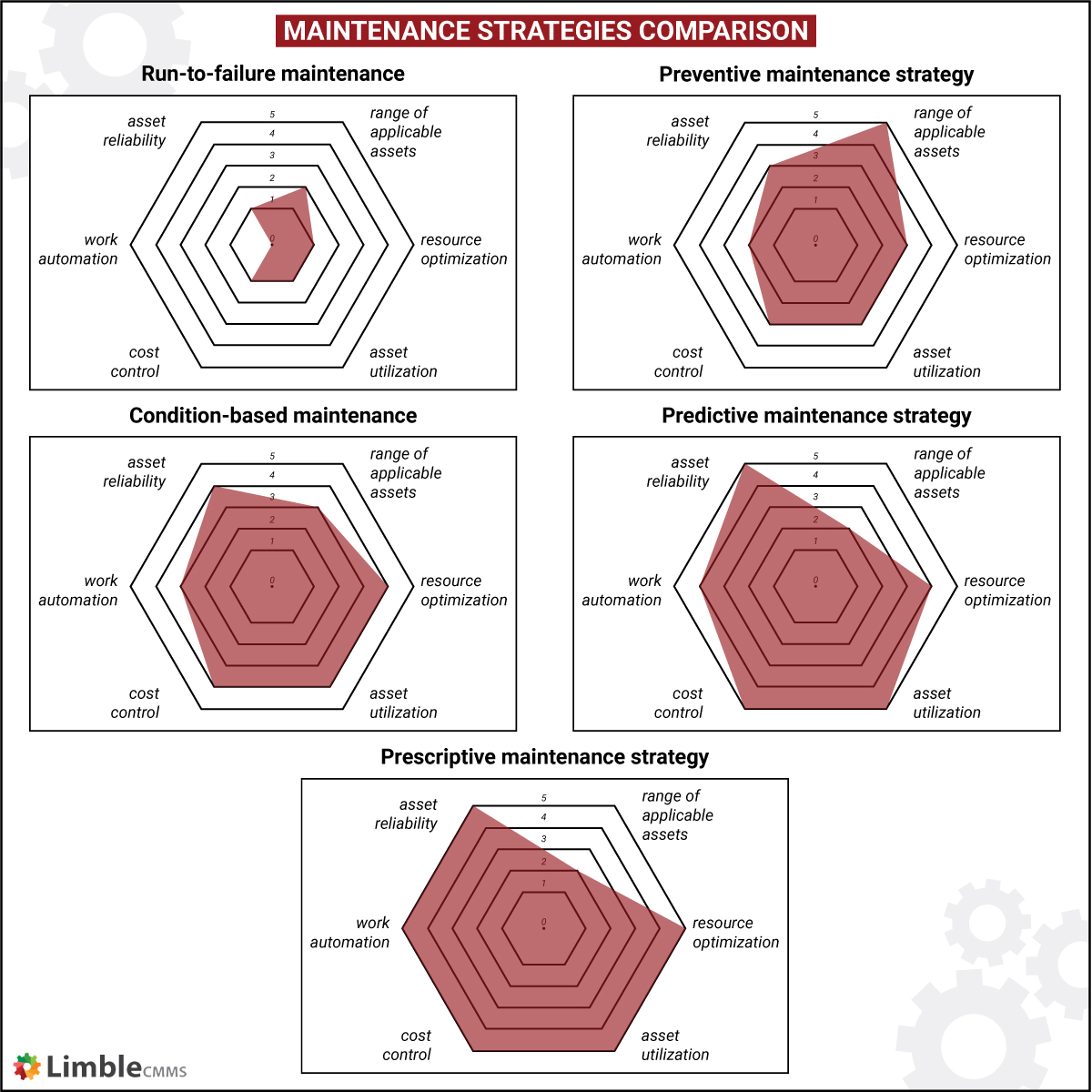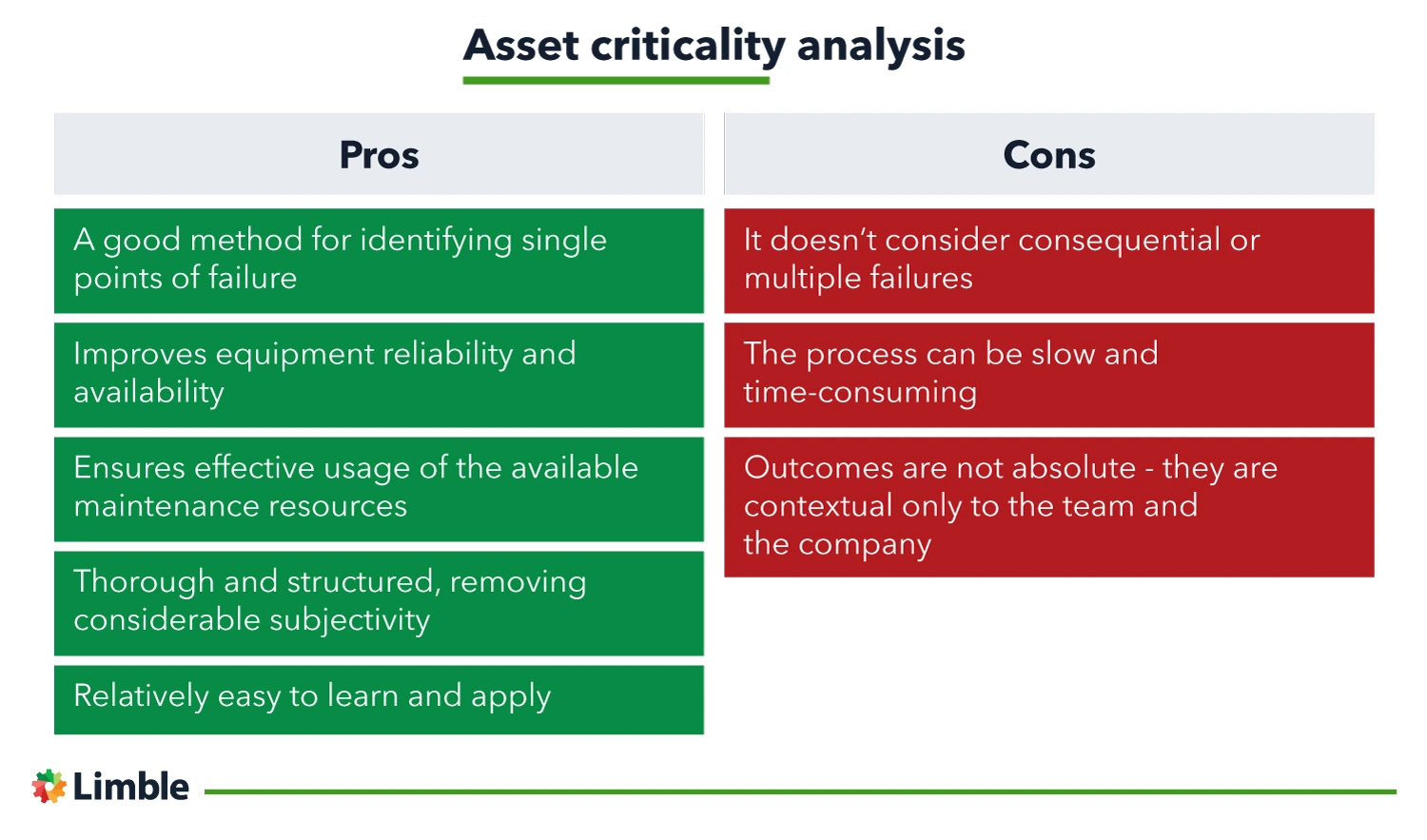If your business uses assets to deliver a product or service, your dependence on these assets introduces risk. Therefore, you implement expensive maintenance programs to offset that risk.
But how do you gauge the effectiveness of your maintenance spend? Are you maintaining the correct assets at the right frequency, and how much are you spending unnecessarily?
In this comprehensive guide, we’ll introduce you to a risk assessment and management method that answers those questions – criticality analysis.
What is criticality analysis?
Criticality analysis (CA) is a structured and systematic method of assessing the risk asset failures pose to a business. The method is used to rank the criticality of assets relative to each other. This supports the implementation of targeted plant maintenance strategies proportional to the failure’s impact.
The structured process removes considerable subjectivity while optimizing maintenance spending. It helps improve asset availability and reliability, plant safety, and equipment uptime.
What is the purpose of completing an asset criticality assessment?
Criticality analysis is not just another maintenance tool for the engineering and maintenance department to save money. It’s a strategic business process requiring involvement and input from a broad range of company departments if it is to deliver company-wide benefits.
The outputs from a criticality analysis can be used for:
- Inventory optimization: Identifying optimum spares holdings for critical equipment.
- Capital allocation: Identifying CAPEX investment for critical equipment upgrades or process redundancy needs while eliminating unnecessary spending.
- Safety improvements: Reducing critical failures and eliminating unnecessary maintenance interventions and downtime.
- Maintenance program optimization: Assists priority rankings for planned maintenance tasks and work order requests. Assists with applying risk mitigation strategies such as condition or trend monitoring.
- Resource optimization: By better understanding asset criticality, maintenance resources are used more effectively.
Sub-optimal approaches to assessing equipment criticality
Different methods exist for applying criticality rankings to assets. However, many lack procedural rigor and miss the mark when it comes to improving maintenance outcomes.
We will still go through some of them so you get the idea what is out there. You might also apply them as a band-aid until you have enough resources to conduct a fully fledged equipment criticality analysis.
The Pareto principle (a.k.a. the 80/20 rule)
This method is subjective and involves the maintenance manager ranking all assets by their perceived criticality, then focusing most maintenance efforts on the top 20% of the list. While some asset failure rates improve, others will deteriorate due to a lack of attention, forcing the maintenance team into reactive mode.
Forced ranking
Like the Pareto method, forced ranking assumes a clear hierarchy of asset criticality, which is not the reality. With scheduled maintenance efforts applied from the top, assets that are towards the bottom-half of the list will receive little to no attention, depending on the maintenance team’s workload.
This method is wildly unpredictable, preventing informed and systematic changes to improve asset availability and measure effectiveness.
Maintenance frequency allocation
The frequency allocation method increases or decreases scheduled maintenance interventions based on asset criticality. However, effective and efficient maintenance is not linked to how often a piece of equipment is looked at, but rather having the right tasks acquitted at a predetermined time.
Frequency allocation often allows less critical assets to run late on scheduled checks or has them canceled altogether due to time pressures.
Over-maintaining
In this scenario, businesses assume that every asset is equally important. Based on the flawed principle that if a little oil is good for something, more must be better, the business gives all the assets equal attention.
Apart from being extremely expensive and time-consuming, there is a sting in the tail. When an asset fails, as one surely will, management will look at the size of the maintenance budget and assume the maintenance department is incompetent.
The fact a business is spending a lot of money on maintenance does not mean the maintenance adds value.
The Essential Guide to CMMS
The Essential Guide to CMMS

How to conduct criticality analysis
The criticality analysis process is essentially a decision-making tool that can be used for managing failure events. As such, it can be split into seven distinct steps you should follow to ensure the assessment is performed correctly and with enough rigor.
1. Assemble a cross-functional team
The value in a criticality analysis comes from the diverse inputs of those in the organization impacted by equipment failure. Using only maintenance or engineering personnel to carry out the analysis can skew the data-gathering process and provide sub-optimal results.
Ensure that operations, procurement, safety, maintenance, and engineering personnel form the team’s core. Additional members might include people from finance and logistics.
2. Agree on the equipment criticality assessment matrix
A common area of contention is the risk assessment matrix. Team members often have disagreements on the applied severity ratings, wording, inclusions, and exclusions.
Begin by proposing draft categories and risk matrices, and allow discussion on the contents. Once everyone has voiced an opinion and suitable modifications have been made, you’ll achieve greater ownership of the process by the team, and ensure consistency when ranking risk.
3. Identify items to be assessed
The criticality analysis process can be quite involved and time-consuming, so keep the number of assets to be analyzed manageable. Aim for the most critical assets when assessing failure risks. Suggestions for the number of assessment items range from 10% to no more than 20% of your total assets.
4. Set the context for each asset
Given the analysis team comprises diverse skill sets, it’s important to clarify the function of each asset, the quantity in use, asset prioritization, and any redundancies that may exist for the item.
An asset that forms a single point of failure with severe financial impacts will have a different criticality or RPN number than if operations can continue using a backup asset or alternative production methods.
5. Collect the necessary data
Identify asset failure modes, the impact of each failure, and the likely rate of occurrence. If you are using the RPN process (the quantitative approach), assign detection rates as well.
6. Perform risk evaluation
Using the risk tables, compute a criticality number for the qualitative analysis or an RPN number for the quantitative analyses. This process can take some time, as each team member will have differing views on how a failure impacts their department and the severity to be applied. High risk can have different meanings for different personnel.
Remember that criticality will be based on the most severe outcome. An in-depth effects analysis is the first step in the methodology, leading to an asset criticality ranking for each asset.
7. Aggregate asset criticality
By aggregating the criticality rating from all assets, you gain insight into where and how you might best allocate resources for optimum effect. While criticality analysis does not consider consequential or multiple failures, risk aggregation might inform contingencies suitable to offset several identified potential failure impacts.
Optimizing maintenance using criticality outcomes
The outcome of a criticality analysis can be used to inform various strategies. These may include equipment design, modification to processes, equipment guarding, Capex for new equipment, or other positive actions to reduce failure severity.
However, when we specifically wish to optimize our asset management and maintenance, one of the key areas for improvement is the maintenance, inventory, and procurement strategies we employ. There are five maintenance strategies common to most facilities:
- Run-to-failure maintenance
- Preventive maintenance
- Condition-based maintenance
- Predictive maintenance
- Prescriptive maintenance

For those who were intrigued by the graphic above, check our detailed comparison of the maintenance strategies here.
With insight into the failure impacts of an individual asset, we can consider whether the current maintenance regime is providing effective and efficient mitigation of equipment failure.
Example #1: Low criticality asset
An example might be an asset deemed low in criticality due to multiple redundancies. In this case, carrying out condition-based maintenance might be overkill, expending maintenance resources unnecessarily.
You might choose to downgrade the asset maintenance strategy to preventative maintenance, carrying out only lubrication and cleaning tasks. You may also choose to be completely reactive in your maintenance, fixing the asset only once it has failed. The final decision will depend on the value of the asset and its repair or replacement costs.
Example #2: High criticality asset
Conversely, you might have identified a slurry pump with multiple redundancies, yet a catastrophic failure would result in severe environmental impacts and regulatory penalties. With such impacts affecting a business’s operating license, averting such failure must be a high priority.
You may choose to install sensors and utilize predictive or prescriptive maintenance techniques to ensure an early warning of deterioration, allowing for a timely maintenance intervention. This example might also necessitate a change in your spares inventory to ensure adequate components or complete units are on hand for rapid rectification.
Developing mitigation strategies
As an extension of the criticality analysis process, you could choose to develop a mitigation matrix. This matrix suggests a range of strategies and tactical interventions to be considered for each criticality ranking, as shown in the image below.
While not prescriptive, the matrix provides an aide-memoire to guide engineers, maintenance planners, and maintenance managers on suitable risk mitigation options while offering other considerations, such as inventory or procurement issues.
Improving criticality assessment with a CMMS
A criticality analysis has three key stages:
- Data gathering
- Asset ranking
- Strategy implementation and monitoring
A computerized maintenance management system (CMMS) provides support through all three stages.
The CMMS provides objective historical maintenance and in-service performance during data gathering activities, informing the initial asset selection for analysis. The criticality analysis team can then base their assessments on empirical data rather than anecdotes and memory.
Once a strategy is identified, the CMMS will manage the task scheduling, resources, and spares necessary to implement the risk mitigation. It will update inventory counts and capture expenditure.
Last but not least, CMMS simplifies financial and operational reviews which are carried out to validate whether the chosen mitigation strategy provided the efficiency and effectiveness gains (by comparing current and past asset performance and maintenance costs).
Let’s summarize
Correctly performing criticality assessment requires diverse organizational inputs and the ability to follow a structured and systematic approach. The rigor used to identify risk, rank it, and implement risk mitigation strategies removes a large degree of subjectivity from the analysis. It prevents isolated actions or the implementation of tactics unsupported by data.
While the process is comprehensive and time-consuming, the benefits are hard to dismiss: a more targeted maintenance program, optimized maintenance spending, reduced operational risk, and improved asset longevity and availability.
That’s it from us – may your equipment live long and prosper! If you have any questions about criticality analysis, visit the comment section below. For anything else related to Limble CMMS, you can contact us here.

